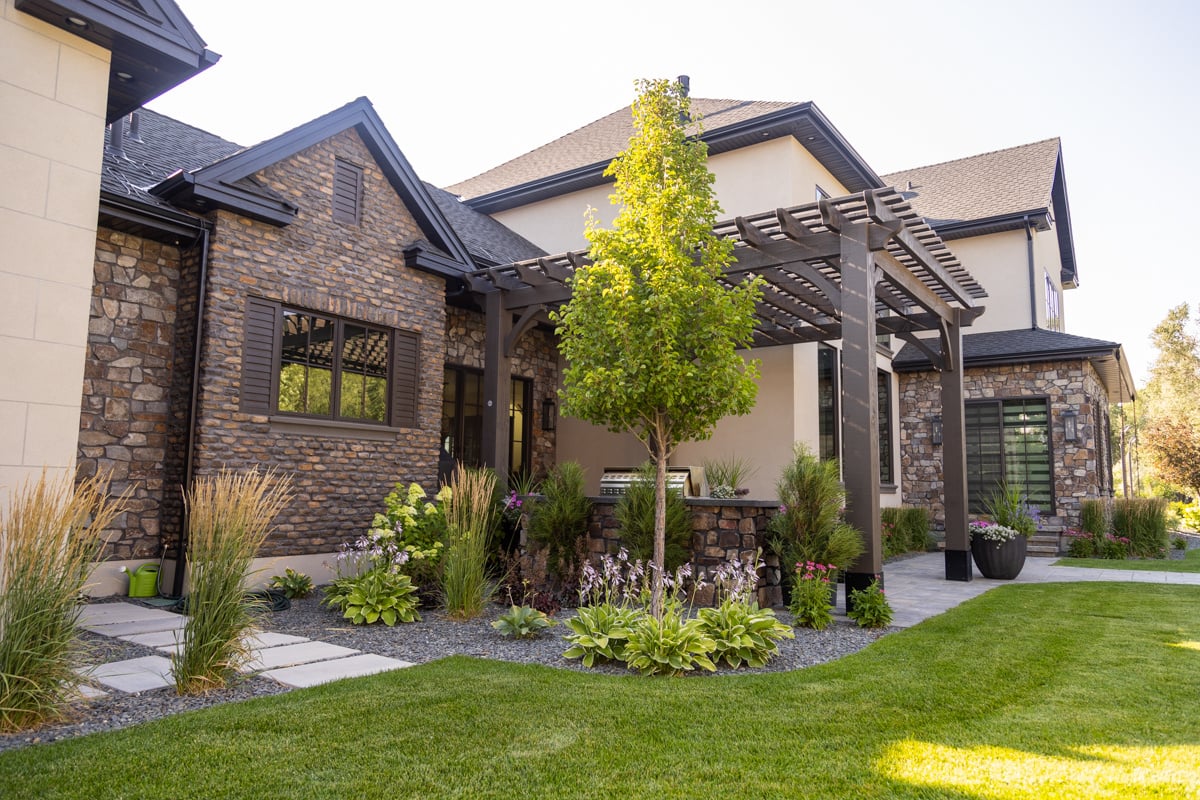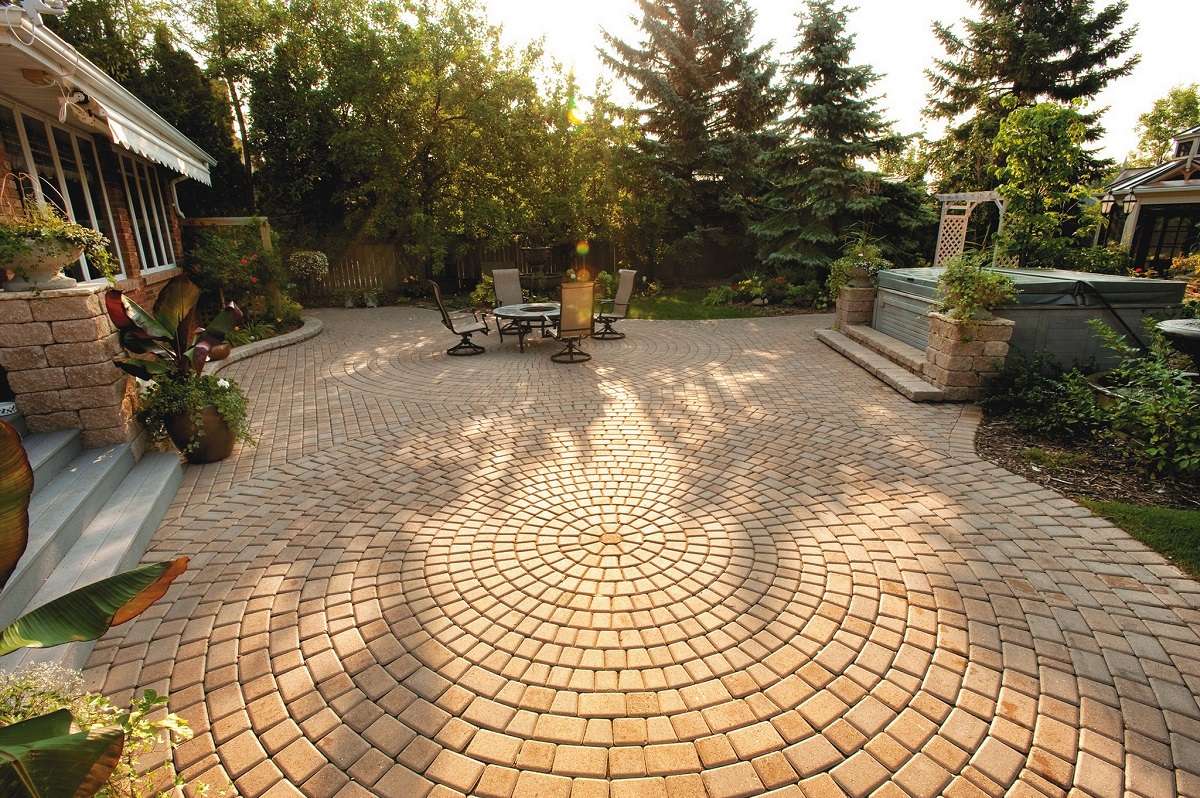

10 Ornamental Trees That Are Safe to Plant Near Your Home's Foundation
Plant the wrong tree too close to your house, and you could be living a scene from a Godzilla movie: your foundation cracked, your house heaving, roots on a rampage!
Is it OK to plant trees near a house? What kind of trees won’t damage your foundation?
You’re in luck — Outback Landscape designers Kim Rubert and Kirk Jeppesen have lots of suggestions, from flowering beauties that explode in bloom each spring to fall color standouts to textural evergreens that offer winter interest.
Keep reading for a list of their top picks, plus other helpful information, including:
- Is it OK to plant trees near a house?
- What kind of trees won’t damage your foundation?
- Flowering trees that won’t damage your foundation
- Colorful fall foliage trees
- Foundation-safe evergreens
- The importance of expert installation
Is It OK to Plant Trees Near a House?
The best foundation planting designs include a mix of different plants — low-growing ground covers, graceful grasses and perennials, mid-size shrubs, and, yes, evergreens and ornamental trees.
But not just any trees. Sprawling tree roots and foundations don’t mix.
As tree roots grow, they branch out into the soil for moisture. If planted too close to your house, they can hit your foundation, and they’re powerful enough to damage it.
So you want foundation planting trees that don’t have extensive, far-reaching roots.
Even trees with smaller root systems should still be planted a foundation-safe five feet away from your house to avoid tree root foundation damage.
“It’s best to plant things that have a smaller mature size near buildings,” Rubert says. “Root systems will rarely get larger than the canopy of the tree, so that’s a good gauge for how far away we need to plant things from the foundation.”
If the mature size of the tree canopy won’t touch your house or building, she says, “then you should be good as far as the roots are concerned.”
What Kind of Tree Won’t Damage Your Foundation?
While sprawling shade trees like big oaks, maples, and poplars have extensive root systems, smaller ornamental trees like crabapples and dogwoods are great options, Rubert says, but the client’s preference takes the lead.
“If they don't want dropping fruit near their house, then we probably won't put a flowering tree up close to their house,” Rubert says.

Rubert and Jeppesen take the home and landscaping’s style into account, too.
Rubert says a tall, slender evergreen tree works well in a formal design, and a graceful flowering crabapple is appropriate in many different design styles.
Trees That Won’t Damage Foundations
Plenty of great trees make the cut when Rubert and Jeppesen plan foundation planting designs.
Among their favorites:
Flowering Trees That Won’t Damage Your Foundation
Nothing ushers in the long-awaited Idaho spring like a tree bursting with fluffy blooms.
Check out these flowering foundation-safe picks:
Lollipop Crabapple
With its petite size, cloud-like white blossoms, and glossy red fruit, the Lollipop crabapple is a sweet choice for foundation plantings.
Small, with a round crown atop a sturdy trunk, it grows 8-10 feet tall and 8-10 feet wide. It has yellow fall foliage and small, glossy red berries that last through winter.
Prairifire Crabapple
%20Prairiefire%20CC.jpg?width=1000&height=665&name=Crabapple%20(Malus)%20Prairiefire%20CC.jpg)
Pinkish-red blooms explode in spring, and red fruit lasts into late fall. Not too much of it drops to cause a mess. It has a 15—to 20-foot height and spread.
Weeping Cherry 'Pendula'
.jpg?width=3904&height=2929&name=Weeping%20Cherry%20-%20Prunus%20subhirtella%20Pendula%20(CC).jpg)
The weeping cherry puts on a show with delicate pink flowers billowing along each branch every spring.
Valued in spring for its flowers, it’s appreciated year-round for its graceful draping form.
Yellow and red fall color add extra interest, and birds gobble up the dark red cherries. This foundation-safe tree still stands out in winter with its distinctive weeping branches.
Chanticleer Pear
.jpg?width=1000&height=665&name=Callery%20Pear%20Tree%20(Pyrus%20calleryana%20Chanticleer).jpg)
This pretty pear has white blooms but produces little to no litter, so it’s great for foundation planting areas where you want to keep things tidy.
It grows 25 to 35 feet tall and can spread 16 to 25 feet. It blooms in April and May, and its leaves turn orange to red-purple in the fall.
Foundation-safe Trees with Colorful Fall Foliage
Celebrate fall with front-yard foliage to wow the whole neighborhood. Consider these knockout choices:
Crimson Spire Oak
A hybrid between English oak and White oak, it has the best features of both. It’s only 15 feet wide, and because of its narrow, upright shape and ability to fit nicely in small spaces, it’s a tree safe to plant near a foundation. Bonus: stunning red fall color.
Swedish Aspen

Hardy, with a pretty fall color, Swedish Aspen have rounded leaves that rustle in the breeze, adding a soothing sound to enjoy from your front porch.
It’s narrow and great for small spaces, like foundation plantings. It’s also happy in cold climates. It pretty much has it all.
Tiger Eyes Sumac
This sumac’s striking foliage features deeply cut, almost lacy yellow leaves. In autumn the leaves turn a brilliant scarlet-orange layered over the yellow — almost luminous.
Fuzzy-looking, purplish-pink stems contrast with the lemony foliage. Even the branches are pretty, offering winter interest.
Ivory Halo Dogwood
Prized for its colorful stems, variegated foliage, and compact size, this dwarf dogwood has brilliant red winter stems and showy, light green leaves with creamy white margins. It’s smaller than many other dogwoods, making it perfect for foundation-safe trees.
Foundation-Safe Evergreens
A striking evergreen adds texture and interest to your foundation planting year-round.
Go green with these foundation-safe trees:
Skyrocket Juniper
Probably the skinniest juniper out there, it lives up to its name. Durable and versatile, it boasts beautiful bluish-green foliage but needs little care. They can grow up to 20 feet tall but stay a skinny 3 feet wide, making them safe trees for foundation plantings.
Weeping White Spruce
Pendulous branches cascading to the ground covered with short, densely packed needles add a graceful, weeping effect to your foundation plantings. It stays nice and narrow, with a spire-like shape.
Columnar Norway Spruce
A narrower, smaller version of the Christmas tree-shaped Norway spruce, this striking spruce has steely-blue needles that offer textural interest all year.
They can grow to 20-30 feet tall but stay narrow, making them good foundation-safe trees.
Foundation-safe Trees: Get Expert Installation with Outback
Hiring the right landscaping team to install them is just as important as choosing the right foundation-safe trees.
Outback pros will ensure that you choose foundation trees that thrive in your soil and light conditions, look great in your landscaping, fit your space and won’t damage your foundation.
Which trees are safe to plant near a house?
We’d love to help you decide.

Outback Landscape is a full-service landscaping company offering landscape design and planting in Idaho Falls, ID, Southeast Idaho, and Wyoming.
We install beautiful, functional landscapes and stay with you for the long haul, taking care of your property through all four seasons.
We serve residential and commercial properties in Idaho Falls, Rexburg and Pocatello, Idaho, and Bonneville, Madison and Bannock counties. Call us at 208-656-3220 or fill out the contact form to schedule a no-obligation meeting with one of our team members. We can’t wait to hear from you.
Image Sources | Prairiefire Crabapple, Weeping Cherry, Chanticleer Pear, Swedish Aspen, Skyrocket Juniper
If You're Looking For a Sign, This is It.
Seriously, that lawn isn't getting any better on it's own. Mrs. Jones just called the HOA on you
.jpg?width=480&name=Chase%20Coates%20Team%20Portrait%202%20(2).jpg)
Chase Coates
Chase Coates is the owner of Outback Landscape in Idaho Falls, Idaho.


How Much Does It Cost to Install Pavers? Including Labor & Materials
.jpg)


